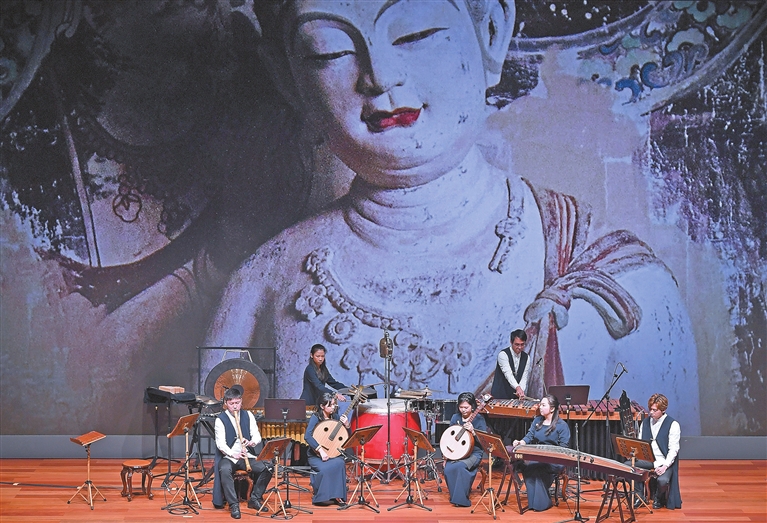
AS the orchestra filled the air with enchanting melodies that seemed to echo from centuries past, the vibrant fusion of cosmopolitan Hong Kong and Gobi Desert oasis Dunhuang in Northwest China’s Gansu Province breathed life into ancient murals, creating a mesmerizing spectacle. At the opening of the Hong Kong Palace Performing Showtime Carnival on Nov. 26, 2023, young musicians played ancient instruments while giant murals from the Mogao Grottoes flickered on the big screen. Like a vivid tapestry unfolding before the audience’s eyes, the music intertwined with the rich hues and intricate brushstrokes, awakening the dormant figures and transporting listeners through time. The performance was a testament to the enduring power of art and culture to bridge time and space, connecting the present with the past and creating a sense of wonder and awe. Driven by a profound commitment to reviving and preserving Dunhuang’s rich cultural legacy, the Hong Kong Gaudeamus Dunhuang Ensemble is infusing renewed vitality into the ancient melodies enshrined within the murals. Leonie Ki, the ensemble’s honorary director and founder, fell in love with Dunhuang during her first visit in 2010, and since then, she has been there 15 times. In October 2017, Ki led a group of aspiring young musicians to visit the Mogao Grottoes in Dunhuang. It was Ki’s first time entering Cave 112, which features the famous image of the “playing pipa behind the back.” The visitors revealed that the mesmerizing murals had left them both astonished and deeply moved. It was at that very moment that Ki, inspired by this profound experience, resolved to establish an orchestra. The allure of Dunhuang’s rich cultural heritage had entranced her, as had the unwavering commitment of those who came before her, such as renowned Chinese painter Chang Shuhong and archaeologist Fan Jinshi. These stalwart guardians had dedicated their lives to upholding the indomitable “Mogao Spirit” that epitomizes perseverance amid the desert’s unforgiving terrain, prompting Ki’s profound admiration. Thus, in May 2018, the Hong Kong Gaudeamus Dunhuang Ensemble was born. Merely four months later, they took the stage as representatives of Hong Kong at the esteemed third Silk Road (Dunhuang) International Cultural Expo, delivering a mesmerizing performance at the illustrious Dunhuang Grand Theater. Their journey reached new heights when an invitation arrived from Wang Xudong, former director of the Dunhuang Academy. The music group was bestowed the honor of performing in front of the iconic “nine-story building” in the Mogao Grottoes. This distinction firmly established them as the solitary performance ensemble hailing from Hong Kong to receive such remarkable recognition. Ki understood the significance of this moment — a resounding testament to the unwavering support bestowed upon the music group, serving as a tremendous source of inspiration. Following the prevalent depictions found in the murals, the orchestra took shape with eight musicians and two composers. They meticulously selected wind and percussion instruments commonly featured in the artwork, including the evocative curved-neck lute and the resonant mouth organ, among other meticulously replicated ancient instruments. As the ensemble gathered, questions lingered: What melodies should resonate through the air? How does Dunhuang music truly manifest itself when it has remained unheard by contemporary ears? Kam Shing-hei, artistic coordinator and composer-in-residence of the ensemble, undertook his inaugural artistic pilgrimage to Dunhuang during his sophomore year at the Hong Kong Academy for Performing Arts. “At that moment, the stories concealed within those murals eluded my comprehension, yet their visual allure emanated a profound musical essence. The compositions, hues, and strokes bestowed upon me a cornucopia of melodic inspiration,” he reminisced. Gradually, he unraveled that composition requires a profound grasp of the cultural nuances underpinning it. During one performance, Felissa Chan, a pipa player in the ensemble, participated in a trio piece featuring the curved-neck lute, the Tang Dynasty (618-907) sheng (a mouth-blown polyphonic free reed instrument), and the xun (a globular, vessel flute), among other musicians. “Unlike the regular pipa, the curved-neck lute is played horizontally, yielding a poignant sound that evokes a sense of vicissitude,” said Chan. Kam has begun inviting more composers to create works. They continuously improve their performances, using multimedia elements on stage and presenting interactive art installations in public spaces, thus engaging with a wider audience. “In Dunhuang culture, I discovered my true identity and the stories I can narrate through these instruments,” Kam reflected. “I am grateful to have grown alongside the entire ensemble.” (Xinhua) | 
